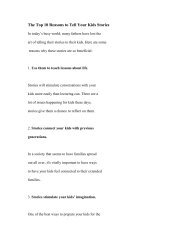Organic Chemistry
Chirality
Chirality
You also want an ePaper? Increase the reach of your titles
YUMPU automatically turns print PDFs into web optimized ePapers that Google loves.
<strong>Organic</strong> <strong>Chemistry</strong> - Ch 11 533 Daley & DaleyObjectives✔ Be able to find molecules that are asymmetric and recognize if anystereogenic centers are present✔ Understand that nonsuperimposible mirror image compounds haveidentical physical and chemical properties in a symmetricenvironment, but are different in an asymmetric environment✔ Know the nomenclature of stereogenic centers✔ Be able to work with Fischer projections of stereogenic centers✔ Know the difference between enantiomers and diastereomers✔ Recognize the techniques used to separate enantiomersTh' wurruld has held a lookin'-glass in front iv ye fr'mth' day ye were born an' compelled ye to make facesin it.—Finley Peter DunneMr. Dooley Says (1910)Chapter 11 continues the study begun in Chapter 3 of thethree-dimensional structural features of molecules. Thiss tudy, known as stereochemistry, is important because the waymolecules react with each other depends, in part, on their threedimensionalstructure. The chemical reactions discussed in Chapter12, and onward, require an understanding of the stereochemistry ofthe molecules. Stereochemistry is especially important withbiologically significant molecules such as amino acids, proteins,carbohydrates, and nucleic acids because they react and behave inways highly dependent on their stereochemistry.So far, you have studied two categories of isomers: structuralisomers and geometric isomers. Structural isomers differ from eachother in the bonding sequences of the atoms they contain. Butane and2-methylpropane are examples of structural isomers. Geometricisomers have identical bond sequences, but the spatial relationshipbetween those bonds is different. For example, cis-2-butene and trans-2-butene are geometric isomers. This chapter introduces a third typeof isomer called stereoisomers. Stereoisomers are molecules that havethe same bond sequence, but different three-dimensional structures.If you have not yet developed the ability to visualize complexobjects in three-dimensions from a two-dimensional representation,www.ochem4free.com 5 July 2005







